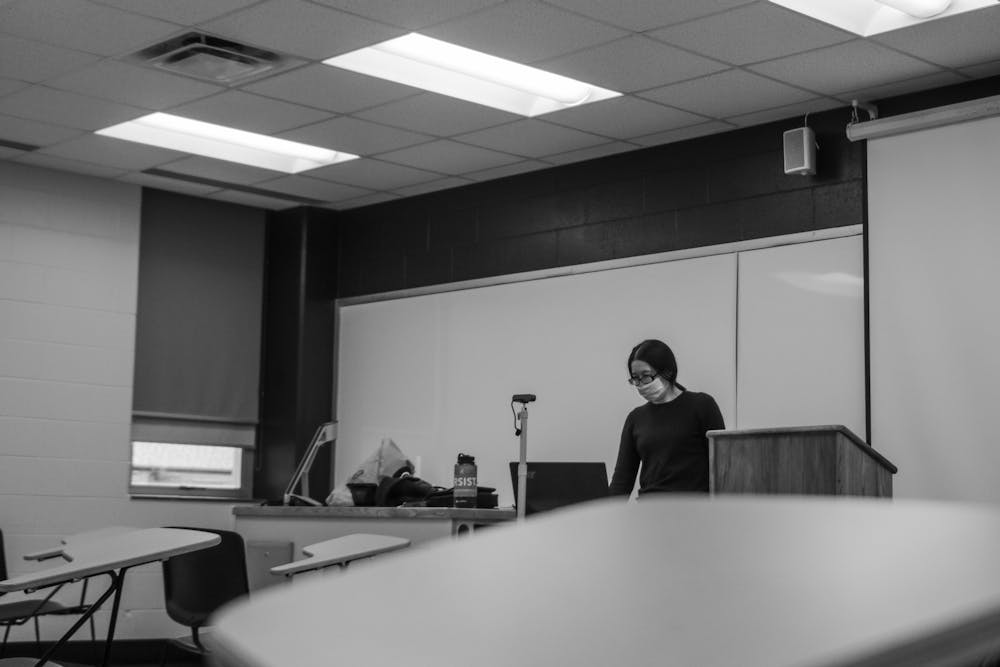One year later: Faculty members discuss struggles, advantages of virtual learning

Graduate teaching assistant, Emma Johnson, asks her virtual 'U.S. History Through Michigan Eyes' class questions about government Nov. 17. Educators are forced to teach in nearly empty classrooms due to guidelines in place to limit the spread of COVID-19.
(This photo was taken for the "Learning in Isolation" photo story. Johnson is not quoted in this story)
A year after Governor Gretchen Whitmer signed the first "Stay-Home, Stay Safe," executive order and just over a year since virtual classes began at Central Michigan University, professors are reflecting on the struggles and achievements they’ve experienced adapting to online learning.
Troy Hicks is an English and education faculty member who specializes in educational technology and digital literacy. He said many faculty members began the pandemic without the proper skill sets to conduct classes virtually. Educators who had been conducting their classrooms the same way for years were suddenly faced with a daunting change.
Even faculty who were well-versed in online classes were facing struggles. Philosophy and religion faculty member Heather Kendrick said her asynchronous classes could have never prepared her for such a change.
“Even when I had taught online in the past, I had never done synchronous classes before, so I had to get used to what felt like an extremely alien way of communicating with people," Kendrick said.
Technology struggles posed the initial challenge. Journalism faculty member Kathy Backus detailed her specific struggles with technology, citing the disruption to learning and engagement.
"It’s really damaging to the delivery of the content and the confidence of the teacher," Backus said. "It totally interrupts the flow of learning.”
Many professors took advantage of the training offered through the Office of Curriculum and Instructional Support (CIS). Pete Ross, executive director of CIS, said in the past year there was a 30 percent increase in Training Session attendees, a 150 percent increase in consultations, and a 200 percent increase in requests for Learning Systems Support.
As professors began adapting to technological changes, they continued to struggle with the lack of human connection. After a year of teaching to empty classrooms and virtual meetings, some have begun questioning their impact as instructors.
“I don’t even know what my students look like unless they turn on their cameras," Backus said. "I can’t even gauge what kind of impact I’m having this year. I’ve certainly had far fewer relationships with students.”
Despite challenges, Hicks has found advantages to virtual learning, working to foster interaction and collaboration in his online synchronous courses. With expertise in educational technology and teacher education, he’s found creative ways to make the most of virtual courses.
"I’ve actually personally enjoyed virtual classes because there are endless resources for collaboration and interactive activities, like breakout rooms, Google Docs, and Adobe," Hicks said. "It's not all about Zoom and WebEx, it's about the underlying style of teaching. It calls on teachers to be creative and think outside of the box."
Kendrick and Backus also noted achievements in virtual learning. They’ve both seen heightened participation in the chat function of Zoom and Webex, as well as opportunities for personal connections in meetings outside of class time.
In an email to campus sent out on March 12, President Bob Davies announced more than 50 percent of courses are scheduled to return to a face-to-face format compared to 10 percent this spring and 2% in Fall 2020.
Until then, Hicks, Kendrick, and Backus all have the same hope - increased student engagement.
“I wish students would feel free to unmute and speak up," Kendrick said. "It makes it more of a conversation if people are speaking out loud, especially if the cameras are on. We need students to meet us half-way.”






